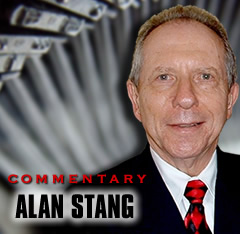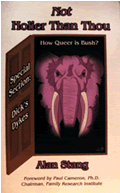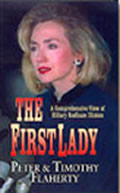Other
Stang
Articles:
PEARL HARBOR, PROVES 9-11 FRAUD
by Alan Stang
December 7, 2007
NewsWithViews.com
Here we are again at the �day that will live in infamy.� I have a modest thought I have seen nowhere else. Let�s look at the horror again, through the eyes of Robert B. Stinnett, who spent seventeen years going through more than 200,000 documents and interviews about it. His book is Day of Deceit: The Truth About FDR and Pearl Harbor, New York, Touchstone (S & S), 2001.
It is crucially important to establish who Robert Stinnett is. In the early years after the devastating attack on Pearl Harbor, through one utterly phony �investigation� after another, Roosevelt�s Socialist idolaters swore up and down that he had known absolutely nothing about it. The possibilities that he knew it was coming and did nothing, or, even worse, that he conspired to arrange it, were labeled psychotic fantasies only a psychiatrist could call serious.
All these years later, however, so much slime has oozed forth that Roosevelt worshippers now stand up to their eyeballs in it. They can�t deny it. So, now they take a totally different position, a diametrically different position. Now they say, yes, Roosevelt knew about it, he even arranged it, because the American people at the time were too dumb to know they needed to be in the war � they needed a big enough shock to trick them into it � so Roosevelt arranged it for our own good.
And it is important to establish that Robert Stinnett is one of these people. He is not a �Roosevelt hater.� He idolizes Roosevelt. He is a decorated veteran of World War II and therefore, like other veterans of that nightmare, has considerable emotion invested in it. Here�s the way he puts it in the preface:
�As a veteran of the Pacific War, I felt a sense of outrage as I uncovered secrets that had been hidden from Americans for more than fifty years. But I understood the agonizing dilemma faced by President Roosevelt. He was forced to find circuitous means to persuade an isolationist America to join in a fight for freedom. He knew this would cost lives. How many, he could not have known.
�The country was disillusioned by the failure of America�s idealistic commitment to make �the world safe for democracy� in World War I. Many Americans had chosen isolationism to shelter their young from the horrors of another war, and believed that Roosevelt would �not send their sons to fight in foreign wars.� Roosevelt believed that his countrymen would rally only to oppose an overt act of war on the United States. The decision he made, in concert with his advisors, was to provoke Japan through a series of actions into an overt act: the Pearl Harbor attack.�
So the Stinnett book is what the criminal lawyers (even some lawyers who are not criminals) call an �admission against interest.� Notice that Stinnett even uses the telltale terminology of the world government crowd. He calls America�s wholesome, fervent desire to mind its own business �isolationism.�
But Stinnett, like your Intrepid Correspondent, is a news man. And like a Dalmatian in a fire house, he apparently could not help but respond to the bell. His book proves beyond even the remotest question � with an endless Niagara of evidence from the government itself � that Roosevelt conspired to arrange the Japanese attack on Pearl Harbor.
A word should be said about Franklin Roosevelt. In World War I, he was Assistant Secretary of the Navy in the administration of Woodrow Wilson, who conspired with First Lord of the Admiralty Winston Churchill to arrange for a German submarine to sink HMS Lusitania, a Royal Navy warship posing as a passenger liner.
Despite strenuous German warnings to passengers � even including newspaper ads � the conspirators continued the pretense, and used the ensuing outrage as a cause c�l�bre to trick the United States into the world government war. Roosevelt held that job for seven years. It is important to understand that he was a real expert on the U.S. Navy.
In 1932, he ran for President. He won by accusing Republican Herbert Hoover of perverting our system by creating big government, by inflicting scores of Socialist bureaucracies on the people, a charge that was true. The people elected Roosevelt because he promised to dismantle Hoover�s big government. Don�t take my word for that. Look at his campaign speeches. If I told you that some Ron Paul forerunner wrote them, you would believe me.
Roosevelt lied, of course. He never had any intention of doing what he said. His New Deal was simply more and bigger Herbert Hoover. Indeed, whenever the economy tried to revive, Roosevelt intervened with more and bigger warmed over Hoover � more programs, more agencies, more handouts, etc. � and it collapsed again. When war erupted, the U.S. economy was just about as bad as it was on Black Friday, 1929. See the unemployment numbers. One of Roosevelt�s �solutions� was to steal the people�s gold.
Now, let�s browse through the Stinnett book. Not only did FDR know about the Japanese attack, not only did he help arrange it, but he also had an eight-step plan to implement it. Throughout the book we learn, according to horse�s mouth Secretary of War Henry L. Stimson, that Roosevelt said, �The United States desires that Japan commit the first overt act.�
In a weird replay of World War I, Churchill was again First Lord of the Admiralty, early in the war. By the fall of 1940, he was PM, and T. North Whitehead of the British Foreign Office, sent him a message from the United States: �America is not in the bag. However, the President is engaged in carefully calculated steps to give us full assistance.� (Preface)
One step in FDR�s treason plan kept our Pacific fleet at Pearl Harbor, not on the West Coast. Vice Admiral James O. Richardson, commander in chief of that fleet, a true hero, strenuously disagreed, because at Pearl his men and the fleet would be in jeopardy. He was fired.
Page 17: �. . . A Gallup poll taken in early September showed that 88 percent of Americans agreed with the views of an isolationist bloc . . . that advocated staying away from Europe�s wars. . . .� So in 1940 a staggering 88 percent of the American people wanted no part of the war. Remember that in his reelection speeches that year, FDR swore up and down that he hated war, his wife hated war, even his dog, Fala, hated war, and he would not send American boys to fight in the war then raging in Europe.
Page 30-31: On January 26, 1941, Max W. Bishop, third secretary at the U.S. embassy, Tokyo, cables the State Department: Many sources say that �the Japanese military forces planned in the event of trouble with the United States, to attempt a surprise attack on Pearl Harbor using all of their military facilities. . . .� Remember, this is more than 10 months before the attack.
Page 31-32: Lt. Cdr. Arthur McCollum, author of Roosevelt�s eight point plan, head, Far East desk, Navy intelligence, sends as follows to Adm. Husband E. Kimmel, Richardson�s successor as new commander of the pacific fleet, on 2/1/41: �The Division of Naval Intelligence places no credence in these rumors. . . . . no move against Pearl Harbor appears imminent or planned for in the foreseeable future.�
Admiral Kimmel kept trying to get intelligence, but gradually became aware that Washington was withholding it. Of course, he could not have imagined why. Stinnett reports that by late July, 1941, he was cut off from intelligence completely.
One of the enduring Roosevelt Pearl Harbor myths says that Japanese naval forces never broke radio silence, so there was no way to know they were on their way to attack Pearl. Stinnett utterly buries that myth under a mountain of U.S. government documents. Admiral Yamamoto and other Japanese commanders broke radio silence again and again, even giving their route and location.
Roosevelt knew this because Navy intelligence had broken the Japanese code, but Washington withheld that fact from Kimmel. The U.S. Army commander at Pearl was General Walter Short. He intercepted Japanese messages but couldn�t decode them and sent them to Washington. Despite his pleas, Washington would not tell him what they said. Washington intercepted bomb plots at Pearl but did not tell Short.
Kimmel and Short did not learn until later that they were being set up as fall guys who would take the rap for the treason in progress. All of this was concealed in the phony post-war �investigations.� Key witnesses were not called. The conspirators falsified documents. They re-dated documents. Some documents that could not be falsified or re-dated simply disappeared.
Page 158: On 11/15/41, Army Chief of Staff George C. Marshall says in a secret press conference that we�ll be at war with the Japanese during the first ten days of December, 1941. But Marshall doesn�t bother telling this to Kimmel and Short! Washington told Short again and again to watch for sabotage, not for attack. Sabotage requires an entirely different kind of planning. Washington told our Pearl Harbor commanders the Japanese would attack the Philippines.
Page 186-87: Author Stinnett writes as follows: �None of the nine Pearl Harbor investigations examined the TESTM dispatches or questioned why their crucial data were cut from Kimmel�s intelligence loop. Since he was never told, the admiral could not raise the question in his own defense. . . . In April 1995, Congress . . . directed that the Department of Defense conduct an investigation. But the TESTM documents were not produced by the DOD, even though they had been released by the FOIA. Captain Duane Whitlock�one of America�s most honored and heroic code-breakers�was available to explain and identify the dispatches in both 1945 and 1995. He was never asked to testify.�
Page 203: Lt. Cdr. Joseph J. Rochfort, who commanded Station HYPO, Pearl Harbor, said later of our losses: �It was a pretty cheap price to pay for unifying the country.� I admit I do not understand this. As I read it and re-read it, my mouth falls open. The only way I can keep it in my head is to recognize that I am looking at an utterly different kind of mentality. Rochfort is a U.S. Navy officer. The price he says was pretty cheap was the mass murder of about 3,000 fellow Americans, many of them fellow U.S. Navy sailors.
As I write, I can see in mind�s eye the sailors trapped in the hull of a capsized battleship. It is dark, not just dark, but so dark they can�t see their fingers in front of their own nose. The water is rising. The air is running out. They tap on the hull. Some were rescued. Hundreds were not. The rescuers couldn�t get to them.
The tapping apparently continued for a couple of weeks. That�s right; it took two weeks for those sailors to die in the dark. Today they are entombed, still at Pearl. The movies have immortalized Rochfort as a hero. I would have hanged him. Of course, remember, I do not understand.
Loc.cit: �Seven Japanese naval broadcasts intercepted between November 28 and December 6 confirmed that Japan intended to start the war and that it would begin at Pearl Harbor. The evidence that poured into American intelligence stations is overpowering. All the broadcasts have one common denominator: none ever reached Admiral Kimmel. . . .�
P. 204: �There is not the slightest reason to believe that JN-25 or any other navy system contained anything that would have forecast the attack.� So says Lt. Cdr. Thos. Dyer, second in command to Rochfort as chief cryptographer at HYPO, in a letter to the author dated 6/4/83. But Station H Japanese radio intercepts make him a liar.
Page 208: Washington sent mutilated summaries to Kimmel in late November and early December. Yes, that is correct. We are talking about physical mutilation. More than 65 summaries were �crudely cut� to omit the information Admiral Kimmel needed. Page 226: On December 5, Tokyo sends two messages that war with U.S. would start on December 7. The messages were decoded immediately but not sent to Pearl.
Page 227-28: Tokyo sends a four part message starting on December 6 to Ambassador Kichisaburo Nomura in Washington, severing relations and instructing him to deliver it at 1 pm Sunday, the next day, December 7, which was 7:30 am in Pearl. U.S. intelligence intercepted, decoded and translated the message even before Nomura got it. So FDR, Marshall & Co. knew that at 7:30 am, Japan would take some hostile action. What would you do if you were Army Chief of Staff?
Page 228: Here is what Marshall did, says Robert Stinnett: �Instead of picking up his scrambler telephone and tipping off General Short to the 1:00 P.M. deadline, Marshall sent the warning to Hawaii using a combination of Western Union and RCA, a slower method. . . . It includes a later attempt to distance Pearl Harbor investigators from Marshall and the 1:00 P.M. deadline and involves coercion of a U.S. Army colonel to alter his testimony. It even reaches to post-surrender Germany in 1945 when that colonel, Rufus Bratton, was flagged down on the Berlin Autobahn and persuaded to �modify� evidence against Marshall.�
FDR read all this Saturday night and said: �This means war.� Meanwhile, early Sunday morning, Colonel Bratton, who knew the attack was coming, but didn�t know the fix was in, desperately tried to find his boss, Marshall, who conveniently was out horseback riding. Bratton finally convinced Marshall he needed to go to his office, a ten minute trip. Marshall showed up an hour and fifteen minutes later.
Page 255: The Roberts Commission, named for Supreme Court Associate Justice Owen Roberts, conducted an �investigation.� Remember that the purpose of a federal investigation is to conceal and confuse the subject it is �investigating.� Sure enough, the commission was not allowed to see any evidence. Its report, issued on December 24, 1942, was not the Christmas present Short and Kimmel expected.
It absolved Marshall, another traitor President Stang would have hanged, and blamed Admiral Kimmel and General Short. Admiral James Richardson said: �It is the most unfair, unjust, and deceptively dishonest document ever printed by the Government Printing Office. I cannot conceive of honorable men serving on the commission without greatest regret and deepest feeling of shame.�
Stinnett says that four days after the attack, on December 11, Rear Adm. Leigh Noyes, U.S.N. director of communications, told his subordinates: �Destroy all notes or anything in writing.� Page 256: In 1945, Congress was denied access to those Japanese intercepts that would have proved Roosevelt knew. Admiral Ernest King threatened all Navy personnel who knew anything that, if they talked, they would lose all benefits and be imprisoned.
Page 302: From Admiral Isoroku Yamamoto: on November 25, 1941, To First Air Fleet (Pearl Harbor Attack Force) �The task force, keeping its movement strictly secret and maintaining close guard against submarines and aircraft, shall advance into Hawaiian waters, and upon the very opening of hostilities shall attack the main force of the United States fleet in Hawaii and deal it a mortal blow. . . .� That was just one of the intercepts.
So what do we have? Franklin Roosevelt was a liar, a swindler, a robber, a traitor and a mass murderer. Notice that after doing everything he could for a couple of years to provoke the Japanese to attack us, he could at least have warned Admiral Kimmel and General Short, who would have acted immediately to save American lives.
He didn�t because he wanted as many killed as possible to overcome the almost unanimous American desire to stay out of the war. Had �not enough� been killed, had not enough damage been done, the attack on Pearl Harbor would not have been sufficiently convincing to qualify as a casus belli; it would have remained what the diplomats call an �incident,� like the Chinese Communist attack on that U.S. Navy plane early in 2001. Again, it is hard for the normal man to understand the Roosevelt mentality. He was obviously a satanic monster who should have been hanged beside Marshall.
The subtitle of this piece says Pearl Harbor proves that Nine Eleven is a fraud. How can something that happened sixty years before Nine Eleven prove it? What elements do they share, other than the odd fact that both enemy attacks killed about the same number of people?
One of the official elements of Nine Eleven says federal collusion in that enemy attack is unthinkable, because to think it would logically enmesh many of the highest officials in our government. Well paid Washington mouthpieces have used that fact to ridicule any hint of collusion. Treason on such a scale is inconceivable, we are told.
But at Pearl Harbor we have the incontrovertible, undeniable fact, even applauded by their supporters, that top government officials � from the President of the United States on down � conspired to attack the United States. When you know that, it becomes perfectly thinkable that a future President could have participated in another such attack. Rather than a reason for derision, it becomes a speculation worth considering if the facts lead in that direction.
Secondly, one of the arguments designed to discredit any speculation about government collusion says that it couldn�t be possible because so many people would need to be involved and someone eventually would talk. There would be too many people in the plot to keep the secret, according to this argument.
But look at all the people we know for sure were involved in the Pearl Harbor conspiracy. On page 318 of the Stinnett book, there is a list of 36 Americans cleared to read all Japanese intercepts in 1941. Many more people were aware of or involved in elements of the conspiracy. No one talked.
Remember, the Navy threatened everyone who could have talked with loss of benefits, even prison. If someone had, who would have listened? Even today, all these years later, even after Robert Stinnett�s vacuum cleaner research, a host of documents are still sequestered. Maybe as many people kept the secret of Pearl as so far have kept the secret of Nine Eleven.
|
Subscribe to the NewsWithViews Daily News Alerts! |
Here is an example you will recall that proves why premises are so important. There was a time when the four-minute mile was physically �impossible.� A man just couldn�t run that fast. But in the year after medical student Roger Bannister broke the four-minute mile, thirty seven other runners did so.
Can
the excuses! Peel off the slime! Let�s nail the traitors who perpetrated
Nine Eleven, whoever they are.
� 2007 - Alan Stang - All Rights Reserved
Sign Up For Free E-Mail Alerts
E-Mails
are used strictly for NWVs alerts, not for sale
Alan Stang was one of Mike Wallace�s original writers at Channel 13 in New York, where he wrote some of the scripts that sent Mike to CBS. Stang has been a radio talk show host himself. In Los Angeles, he went head to head nightly with Larry King, and, according to Arbitron, had almost twice as many listeners. He has been a foreign correspondent. He has written hundreds of feature magazine articles in national magazines and some fifteen books, for which he has won many awards, including a citation from the Pennsylvania House of Representatives for journalistic excellence. One of Stang�s expos�s stopped a criminal attempt to seize control of New Mexico, where a gang seized a court house, held a judge hostage and killed a deputy. The scheme was close to success before Stang intervened. Another Stang expos� inspired major reforms in federal labor legislation.
His first book, It�s Very Simple: The True Story of Civil Rights, was an instant best-seller. His first novel, The Highest Virtue, set in the Russian Revolution, won smashing reviews and five stars, top rating, from the West Coast Review of Books, which gave five stars in only one per cent of its reviews.
Stang has lectured in every American state and around the world and has guested on many top shows, including CNN�s Cross Fire. Because he and his wife had the most kids in Santo Domingo, the Dominican Republic, where they lived at the time, the entire family was chosen to be actors in �Havana,� directed by Sydney Pollack and starring Robert Redford, the most expensive movie ever made (at the time). Alan Stang is the man in the ridiculous Harry Truman shirt with the pasted-down hair. He says they made him do it.
Website: AlanStang.com
E-Mail: stangfeedback@gmail.com
He didn�t because he wanted as many killed as possible to overcome the almost unanimous American desire to stay out of the war.













